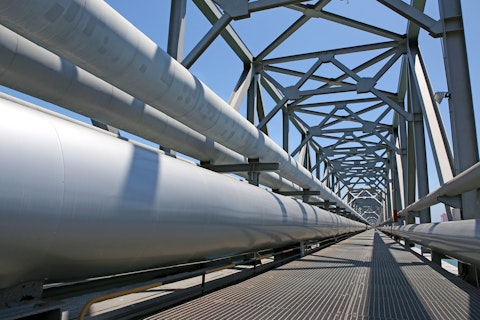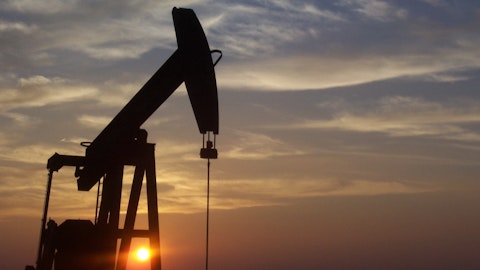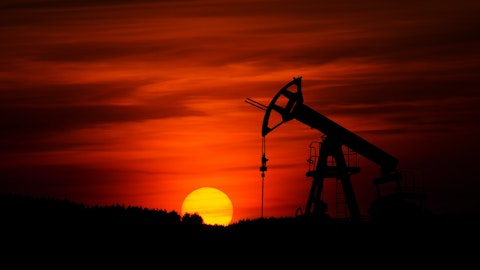In this article, we will discuss the 20 Largest Petrochemical Companies in the World. You can skip our industry overview and go directly to the 5 Largest Petrochemical Companies in the World.
Petrochemicals are an essential part of our daily lives because of their ability to transform oil and gas into a variety of everyday products like plastics, fertilizers, packaging, apparel, digital devices, medical equipment, detergents, and tires. They are used in many components of the contemporary energy system, including solar panels, wind turbine blades, batteries, thermal insulation for buildings, electric car components, and essential items for our daily lives. Petrochemicals are becoming ever more crucial to the global energy system, where they already play a significant role. Since the turn of the millennium, demand for plastics, the most well-known petrochemical goods, has exceeded that of all other bulk materials (such as steel, aluminum, or cement). However, the industry has been in the headlines recently as it contributes to global carbon emissions, and climate activists have been pushing for the industry to move towards more sustainable production.
The global petrochemical market size is projected to be valued at $798.8 billion by 2030, increasing from $523.56 billion in 2022, at a CAGR of 5.4%. The U.S. Energy Information Agency’s International Energy Outlook projects that fossil fuels will supply 60% of primary energy consumption globally in 2050. The United States is a leader in the low-cost production of petrochemicals. Petrochemicals industrial production in the country is expected to be worth $79.8 billion in 2022 and is largely concentrated in Texas, Louisiana, and South Carolina.

tcly / shutterstock.com
According to the Energy Information Administration, USA’s operable crude refining capacity was 17.94 million b/d on January 1, 2022, down from 18.09 million b/d at the start of 2021 and a record high of 18.98 million b/d in 2020 before the pandemic took hold. The estimate for 2022 is the lowest since 14.92 million b/d in 2014. EIA also mentions that refinery capacity might be lower than this figure because of the capacity reductions announced later in 2022. S&P Global suggests various reasons for these refinery closures, including storm damage, pandemic effects, high operating costs, failure to finalize sales, lower future demand predictions, or conversions to generate more renewable fuels.
Moreover, the United States has not built any new refining capacity in decades. The last major refinery in the US came into operation in 1977 in Louisiana. Chevron CEO Mike Wirth made headlines last year when he stated that the United States would never build another refinery. His reasoning was simple: the national policy has been to restrict demand for petrochemicals, making this sector unappealing to investors, given that it takes a decade to recover the initial cost of building a refinery. His views are not incorrect; governments all over the world have been helping the electric vehicle industry to reduce the demand for petrochemicals. According to IHS Markit research, US oil and liquids demand might fall by around 25% from 20.3 million barrels per day in 2019 to an anticipated 15.3 million b/d in 2050. According to IHS’s low-carbon policy scenario, US oil demand for transportation might fall to 7 million b/d by 2050. Globally, Equinor ASA predicts that demand for oil for transportation will shrink 47% between 2018 and 2050 if current trends continue, thanks to advances in fuel efficiency and electric vehicles.
In the near future, the petrochemical industries of the Middle East and China will be the center of attention, with the EIA estimating that they will lead refining capacity increases in 2022 and 2023. The Saudi government is also pushing for a stronger presence in the downstream petrochemical industry to reduce its reliance on crude oil. To achieve this goal, Saudi Arabia has signed several deals with China to collaborate on various projects in the downstream oil business.
Although most analysts believe that demand for petrochemicals will fall in the long term as the global economy shifts to more renewable resources, both the demand and supply of petrochemicals will increase in the next few years. According to McKinsey, continued growth in crucial end markets that utilize petrochemicals, such as packaging and construction, as well as economic development in China, India, and Southeast Asia, will boost demand. Meanwhile, the consulting firm expects supply to grow at a robust rate. However, in the ethylene market category, which dominates the petrochemicals industry, McKinsey predicts capacity to rise faster than demand, lowering profit margins in this segment.
Our Methodology
To come up with the 20 largest petrochemical companies in the world, we identified the biggest petrochemicals companies in major economies and ranked these companies in ascending order in order of their market cap. For private companies, we used a revenue multiple of 1.5x, which we think is a fair valuation multiple for the private companies operating in the petrochemical Industry.
20 Largest Petrochemical Companies in the World
20. Rosneft (ROSN.ME)
Market Cap as of January 22, 2023: $46.66 billion
Rosneft (ROSN.ME) is an integrated oil and gas company with a majority of its shares owned by the government of Russia. Rosneft (ROSN.ME) is involved in the exploration, production, transportation, and commercialization of oil, gas, petroleum products, and petrochemicals. In 2015, Novokuibyshevsk Petrochemical Company merged with Rosneft (ROSN.ME), which is among the largest producers of petrochemicals, gas processing, and organic synthesis products in East Europe and Russia. Rosneft (ROSN.ME) operates several refineries around Russia, selling refined products to both the Russian and European markets. This includes a large number of Rosneft’s filling stations, where the firm makes additional sales of gasoline and diesel fuel.
19. Mitsubishi Corporation (8058.T)
Market Cap as of January 22, 2023: $48.50 billion
Founded in 1950, Mitsubishi Corporation (8058.T) is a conglomerate that operates businesses spanning several industries, including natural gas and petroleum, and chemicals. The company’s natural gas segment explores, develops, and produces oil, natural gas, and natural gas liquids. Mitsubishi Corporation (8058.T)’s petroleum and chemicals segment is involved in the development and trading of oil and its products as well as LPG, chemicals, and petrochemicals, including ethylene, salt, methanol, plastics, ammonia, and fertilizers.
18. BASF SE (OTC:BASFY)
Market Cap as of January 22, 2023: $51.1 billion
Headquartered in Ludwigshafen, Germany, BASF SE (OTC:BASFY) is a multinational chemical company. The company’s operating segments include materials, chemicals, surface technologies, industrial solutions, agricultural solutions, and nutrition and care. BASF SE (OTC:BASFY) supplies products for the chemical, petrochemical, automotive, agricultural, oil, construction, plastics, electronics, furniture, electrical, and paper industries and also offers various system solutions and services.
17. Valero Energy Corporation (NYSE:VLO)
Market Cap as of January 22, 2023: $55.0 billion
Valero Energy Corporation (NYSE:VLO) is an independent refiner that operates 14 refineries in the United States, United Kingdom, and Canada, with a daily total throughput capacity of 3.2 million barrels. Valero Energy Corporation (NYSE:VLO) produces standard gasoline, distillates, petrochemicals, jet fuel, asphalt, lubricants, and other refined products, as well as oxygenates, conventional, low-sulfur, and ultra-low-sulfur diesel fuel. Additionally, Valero Energy Corporation (NYSE:VLO) has 14 ethanol facilities with an annual production capacity of 1.7 billion gallons and also holds 50% shares of Diamond Green Diesel, which can generate 700 million gallons of sustainable diesel annually.
16. Enterprise Products Partners L.P. (NYSE:EPD)
Market Cap as of January 22, 2023: $55.9 billion
Enterprise Products Partners L.P. (NYSE:EPD) is a natural gas and crude oil transmission company. Enterprise Products Partners L.P. (NYSE:EPD) is one of the largest North American midstream oil and gas company that transports and process crude oil, natural gas, natural gas liquids, petrochemicals, and refined products. The petrochemical segment is involved in marketing activities and fractionation of propylene; deisobutanizer operations and butane isomerization; and production facilities for high-purity isobutylene and octane enhancement.
15. Marathon Petroleum (NYSE:MPC)
Market Cap as of January 22, 2023: $58.9 billion
Headquartered in Findlay, Ohio, United States, Marathon Petroleum (NYSE:MPC) is an independent refiner that operates 13 refineries in the American midcontinent, West Coast, and Gulf Coast, with a combined daily throughput capacity of 2.9 million barrels. Marathon Petroleum (NYSE:MPC) operates in two segments: refining and marketing, and midstream. The refining and marketing segment produces petrochemicals such as aromatics, propylene, propane, and sulfur as well as heavy fuel oil, asphalt, and transportation fuels. The midstream segment engages in the transportation, storage, distribution, and marketing of crude oil and refined products through refinery logistics assets, terminals, pipelines, and other transportation routes.
14. Occidental Petroleum Corporation (NYSE:OXY)
Market Cap as of January 22, 2023: $60.8 billion
Founded in 1920, Occidental Petroleum Corporation (NYSE:OXY) is an oil exploration and production corporation. The company operates in three segments: oil and gas, chemical, and midstream and marketing. The oil and gas segment engages in the exploration, development, and production of crude oil, natural gas, and natural gas liquids (NGL). The chemical segment produces basic chemicals and petrochemicals such as caustic soda, chlorine, chlorinated organics, ethylene dichloride, sodium silicates, and vinyl including polyvinyl chloride (PVC), chloride monomer, and ethylene. The midstream and marketing segment is responsible for the processing, transportation, storage, purchasing, and marketing of oil, gas, carbon dioxide, and power.
13. Petróleo Brasileiro S.A. – Petrobras (NYSE:PBR)
Market Cap as of January 22, 2023: $74.7 billion
Founded in 1953, Petróleo Brasileiro S.A. – Petrobras (NYSE:PBR) is a state-owned petroleum corporation based in Brazil. The company operates through several segments, including exploration and production; refining, transportation, and marketing; gas and power; etc. The exploration segment explores and produces gas, NGLs, and crude oil. The refining, transportation, and marketing segment refines crude oil; provides logistics, transport, and marketing for the trading of oil and its products. The gas and power segment generates electricity through thermoelectric power plants and also transports and trades natural gas, LNG, and electricity. At the end of 2021, Petróleo Brasileiro S.A. – Petrobras (NYSE:PBR) had 12 refineries in Brazil with a combined capacity of 1.9 million barrels per day. It also distributed natural gas and refined products throughout the country.
12. China Petroleum & Chemical Corporation (NYSE:SNP)
Market Cap as of January 22, 2023: $77.2 billion
Headquartered in Beijing, China, China Petroleum & Chemical Corporation (NYSE:SNP) also known as Sinopec, is one of the largest oil companies in Asia with the majority of its income coming from its petrochemical production and refining and marketing of oil products. The company’s products include diesel, gasoline, kerosene, jet fuel, ethylene, chemical fertilizers, synthetic rubber, synthetic fiber, and synthetic resins. With more than 30,000 outlets, China Petroleum & Chemical Corporation (NYSE:SNP) has the largest gasoline station network in China and holds a sizable market share in petrochemicals.
11. EOG Resources, Inc. (NYSE:EOG)
Market Cap as of January 22, 2023: $77.9 billion
Founded in 1999, EOG Resources, Inc. (NYSE:EOG) is an American energy corporation that engages in the exploration, development, production, and marketing of natural gas, natural gas liquids, and crude oil. The company serves clients in a wide range of industries, including plastics and rubber, oil and gas, chemicals and petrochemicals, and energy sectors. By the end of 2021, EOG Resources, Inc. (NYSE:EOG) reported net proven reserves of oil equivalent to 3.7 billion barrels. The major operating areas of EOG Resources, Inc. (NYSE:EOG) are Texas and New Mexico in the United States and the Republic of Trinidad and Tobago.
10. Equinor ASA (NYSE:EQNR)
Market Cap as of January 22, 2023: $97.6 billion
Founded in 1972, Equinor ASA (NYSE:EQNR) is a state-owned multinational energy company in Norway. The company explores, produces, refines, markets, and transports petroleum and its derived products, condensates, natural gas, natural gas liquids, and other refined products. The company also has holdings in different oil and gas pipelines and runs refineries, processing plants, storage facilities, and ports. Additionally, it participates in initiatives using hydrogen, solar farms, offshore wind, carbon capture and storage, and other sources of sustainable energy. By the end of 2021, the firm had proven oil and gas reserves equivalent to 5,356 million barrels of oil.
9. BP p.l.c. (NYSE:BP)
Market Cap as of January 22, 2023: $107.1 billion
Headquartered in London, United Kingdom, BP p.l.c. (NYSE:BP) is a multinational oil and gas corporation. Its operating segments include gas and low-carbon energy, oil production and operations, Rosneft segments, and Customers and products. BP p.l.c. (NYSE:BP) engages in: the exploration and production of oil and natural gas; refining, marketing, and supply of petroleum products; generation of solar energy; and produces and markets chemicals and petrochemicals such as acetic acid, terephthalic acid, acrylonitrile, ethylene, and polyethylene. The company runs refineries with a daily oil processing capacity of 1.9 million barrels.
8. TotalEnergies SE (NYSE:TTE)
Market Cap as of January 22, 2023: $157.9 billion
Founded in 1924, TotalEnergies SE (NYSE:TTE) is a French multinational energy and petroleum company. The company operates in the following four segments: exploration and production; integrated gas, renewables, and power; marketing and services; and refining chemicals. TotalEnergies SE (NYSE:TTE) is involved in the production, transportation, and supply of natural gas, crude oil, and low-carbon electricity. It also refines petrochemicals such as aromatics and olefins, and polymer derivatives, including polyethylene, polystyrene, and polypropylene. The refining chemicals segment also engages in biomass conversion and elastomer processing as well as trading and transportation of petroleum products and crude oil.
7. Reliance Industries Limited (RELIANCE.BO)
Market Cap as of January 22, 2023: $202.42 billion
Headquartered in Mumbai, India, Reliance Industries Limited (RELIANCE.BO) is a multinational conglomerate that engages in the exploration and production of hydrocarbons, petrochemicals, refining and marketing, communications, and retail. The company operates in 5 segments that comprise oil and gas, oil to chemicals (O2C), financial services, retail, and digital services. Its chemical-based product line includes petrochemicals, blended yarn, fiber intermediates, synthetic fibers, textiles, and polyester staple fiber. The Oil to Chemicals division generates the majority of income and comprises bulk wholesale marketing, petrochemicals, aviation fuel, and petroleum retailing through Reliance BP Mobility Limited.
6. Shell plc (NYSE:SHEL)
Market Cap as of January 22, 2023: $205.6 billion
Headquartered in London, United Kingdom, Shell plc (NYSE:SHEL) is a multinational oil and gas company. The company’s segments include integrated gas, marketing, upstream, renewable energy solutions, and chemicals and products. Shell plc (NYSE:SHEL) engages in a number of activities, including exploration and extraction of natural gas, natural gas liquids, and crude oil; marketing and transportation of oil and gas; production of gas-to-liquid fuels and other products; and other upstream and midstream activities. It also deals in and refines crude oil as well as other feedstocks including bitumen, lubricants, low-carbon fuels, gasoline, and diesel; manufactures petrochemicals for industrial use, sells them, and oversees oil sands operations. In addition, Shell plc (NYSE:SHEL) also manufactures base chemicals and intermediate chemicals such as ethylene, propylene, aromatics, styrene monomer, solvents, detergent alcohols, etc.
Click to continue reading and 5 Largest Petrochemical Companies in the World.
Suggested Articles:
- 10 Most Advanced Battery Technologies
- 10 Best Healthcare Stocks for Recession
- 12 52-week Low Dividend Stocks To Consider
Disclosure: None. 20 Largest Petrochemical Companies in the World is originally published on Insider Monkey.





